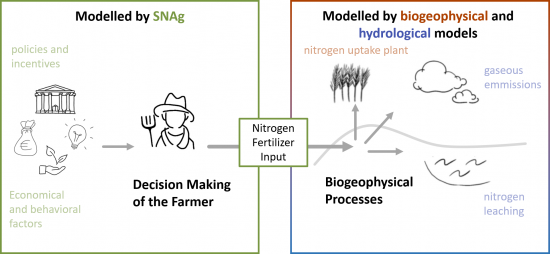SNAg
Leverage Points to Foster Sustainable Nitrogen Usage: A Model-Based Exploration for German Agriculture
Contact persons: Kaja Jurak, Birgit Müller

The usage of nitrogen (N) in agriculture contributes to maintaining high yields while imposing major societal threats as in groundwater pollution, biodiversity losses, climate change and health issues. In Germany, N input in agriculture is highly regulated with even more strict measures applied in nitrogen-vulnerable areas ("rote Gebiete"). Further, N levels in soil and waterbodies are characterized by legacy effects of past nitrogen inputs as well.
However, there exists limited knowledge on the impact of policy interventions targeting changes in farmers' nitrogen management on environmental nitrogen pollution across temporal and spatial scale. We developed the ecological-economic model “SNAg – Sustainable Nitrogen Usage in Agriculture” to explore the trade-offs of N-related policies between maintaining yields, limiting environmental damage, and ensuring the economic well-being of farmers.
Depending on how spatially differentiated a policy measure is, it can affect the effectiveness in terms of nitrogen surplus reduction as well as the associated costs. Thus, one goal of the project is to understand which site-specific factors influence the impact of a policy. Since it is not always possible to target a policy to e.g. every farm in particular, one object of the project is also to quantify the yield loss and costs of uniformly applied policies.